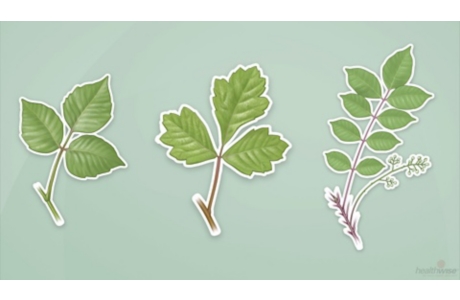Poison Ivy, Oak, or Sumac
Topic Overview
What are poison ivy, oak, and sumac?
Poison ivy, oak, and sumac are plants that can cause a red, itchy rash called allergic contact dermatitis. It is the most common skin problem caused by contact with plants.
What causes a poison ivy, oak, or sumac rash?
The rash is caused by contact with a sticky oil called urushiol (say “yoo-ROO-shee-all”) found in poison ivy, oak, or sumac. You can get the rash from:
- Touching or brushing against any part of these plants, including the leaves, stems, flowers, berries, and roots, even if the plant is dead.
- Touching anything that has come in contact with these plants, such as clothing, sporting gear, gardening tools, or pet fur.
The rash is only spread through the oil. You can’t catch a rash from someone else by touching the blister fluid.
The rash is an allergic reaction to the oil. You become allergic to it through contact. After you have come in contact with these plants, your immune system may start to react to the oil as though it’s a harmful substance.
What are the symptoms?
The usual symptoms of the rash are:
- Itching.
- Red streaks or general redness where the plant brushed against the skin.
- Small bumps or larger raised areas (hives).
- Blisters that may leak fluid.
Some people are very allergic to the oil. In these people, even a little bit of the oil may cause serious symptoms that need medical attention right away, such as:
- Trouble breathing.
- Swelling of the face, mouth, neck, or genitals. The eyelids may swell shut.
- Widespread, large blisters that ooze a lot of fluid.
The rash usually takes more than a week to show up the first time you have a reaction to the oil. It develops in a day or two on later contacts. The rash may form in new areas over several days, but you will only get a rash where the oil touched your skin.
The rash usually lasts about 10 days to 3 weeks. But it may last up to 6 weeks in more severe cases.
How is the rash diagnosed?
A doctor can usually diagnose the rash by looking at it and asking questions about:
- When you were exposed to the plant.
- How long it took the rash to develop.
- Other rashes you have had.
- Your outdoor activities, work, and hobbies.
How is it treated?
If you get a mild rash, you can take care of it at home.
- Apply a wet cloth, or soak the area in cool water.
- Use calamine lotion to help relieve itching.
- Try not to scratch the rash. Scratching could cause a skin infection.
See your doctor if the rash covers a large area of your body or your symptoms are severe. A severe rash may be treated with prescription corticosteroid pills, creams, or shots.
How can you prevent the rash from poison ivy, oak, and sumac?
If you think you have touched any of these plants:
- Wash your skin right away with plenty of water and mild soap (such as dishwashing soap) or rubbing alcohol. Rinse often, so that the soap or rubbing alcohol doesn’t dry on the skin and make the rash worse.
- Use a brush to clean under your nails.
- Wash any clothing or other items that might have the oil on them. Do it right away.
The best way to prevent future rashes is to learn to identify these plants and avoid them.
When you can’t avoid contact with the plants:
- Wear long pants, long sleeves, and closed shoes to help keep the oil from getting on your skin.
- Wear vinyl or leather gloves. Rubber (latex), cotton, or wool gloves offer no protection.
- Use a barrier cream or lotion, such as Ivy X Pre-Contact Skin Solution. It can help keep the oil from coming in contact with your skin.
- If you did not use a preventive product and you have had contact with plant oil, clean it off your skin with an after-contact product as soon as possible. These products, such as Tecnu Original Outdoor Skin Cleanser, can also be used to clean plant oil from clothing or tools.
Experts say not to burn plants like poison ivy, oak, or sumac. When these plants burn, urushiol attaches to smoke particles. Exposure to the smoke can cause a rash on your skin. Breathing in the smoke can also hurt your lungs.
References
Other Works Consulted
- Hall JC (2010). Dermatologic allergy. In JC Hall, ed., Sauer’s Manual of Skin Diseases, 10th ed., pp. 78–104. Philadelphia: Lippincott Williams and Wilkins.
- Shofner JD, Kimball AB (2012). Plant-induced dermatitis. In PS Auerbach, ed., Wilderness Medicine, 6th ed., pp. 1232–1251. Philadelphia: Mosby.
Current as of: April 1, 2019
Author: Healthwise Staff
Medical Review:William H. Blahd, Jr., MD, FACEP – Emergency Medicine & Adam Husney, MD – Family Medicine & E. Gregory Thompson, MD – Internal Medicine & Martin J. Gabica, MD – Family Medicine
This information does not replace the advice of a doctor. Healthwise, Incorporated, disclaims any warranty or liability for your use of this information. Your use of this information means that you agree to the Terms of Use. Learn how we develop our content.




